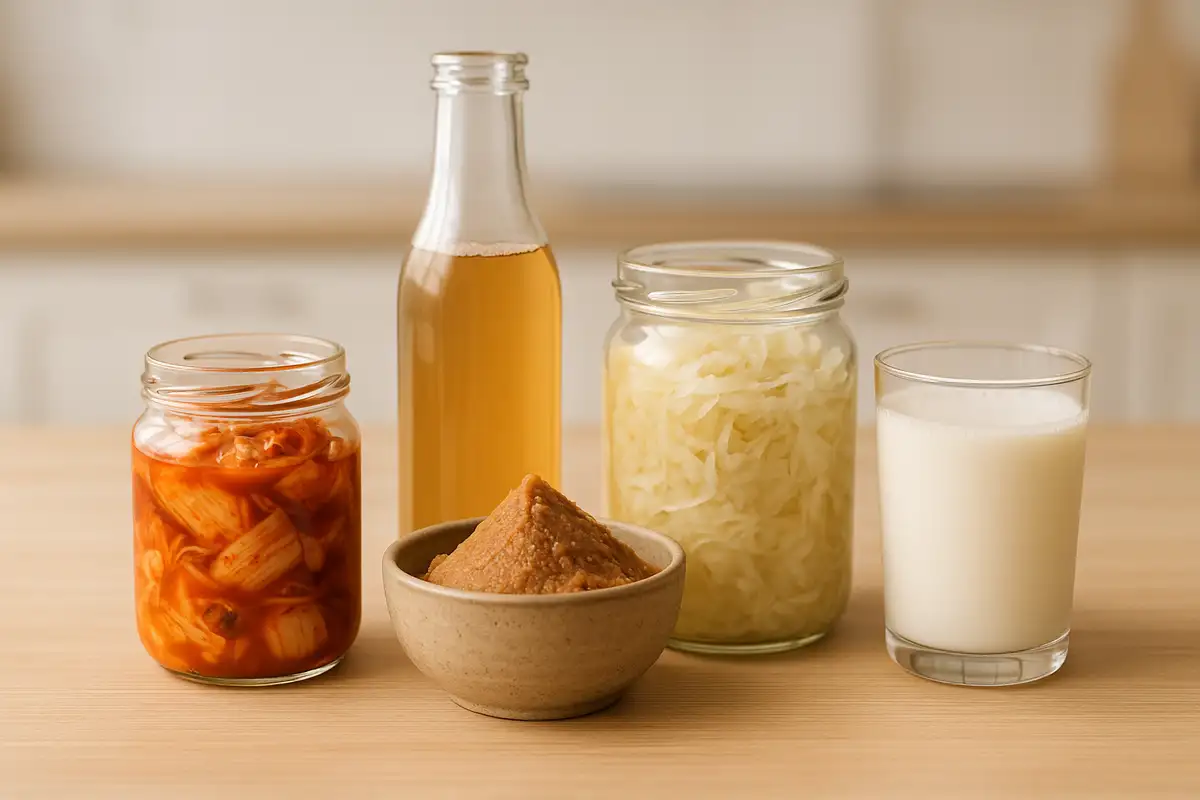Fermented foods have made a serious comeback in American kitchens and supermarkets. From sauerkraut to kimchi, kefir to kombucha, these tangy, zesty items are everywhere—and not just because of the flavor. Fermentation is a natural process in which microorganisms like yeast and bacteria convert carbs into alcohol or acids. This gives fermented foods their distinctive taste and texture, but it also enhances their nutritional value.
Top Fermented Foods by Probiotic CFU Count (per Serving)
| Food | Probiotic Count (CFU) |
|---|---|
| Kefir | 20 billion |
| Yogurt (plain, unsweetened) | 10 billion |
| Sauerkraut (raw, unpasteurized) | 3 billion |
| Kimchi | 2.5 billion |
| Miso | 2 billion |
| Tempeh | 1.5 billion |
| Kombucha | 1 billion |
This chart ranks common fermented foods based on their probiotic content measured in colony-forming units (CFU) per serving. Kefir and yogurt top the list, offering the highest probiotic levels, while kombucha and tempeh provide lower—but still beneficial—amounts.
In fact, fermentation not only helps preserve foods but also creates beneficial probiotics, which are live microorganisms that can improve gut health. And yes, your gut is kind of a big deal—affecting everything from digestion to immunity, even mood.
The Gut-Health Connection: Real Science, Real Benefits
The human gut houses trillions of bacteria, both good and bad. Fermented foods introduce more of the good guys—Lactobacillus, Bifidobacterium, and others—which help crowd out harmful microbes. Clinical trials have shown that people who regularly consume fermented foods experience fewer digestive issues, improved immune responses, and even reduced inflammation (Source: Harvard T.H. Chan School of Public Health).
Here are some evidence-based perks:
- Improved digestion: Yogurt and kefir aid lactose digestion for people who are lactose intolerant.
- Better immunity: A healthier gut supports the immune system, reducing infections.
- Mental clarity: The gut-brain axis suggests better gut health may support mood and cognitive function.
Average Number of Probiotic Strains Found in Fermented Foods
| Food | Number of Strains |
|---|---|
| Kefir | 30+ strains |
| Yogurt | 5–7 strains |
| Kimchi | 4 strains |
| Kombucha | 3–4 strains |
| Sauerkraut | 3 strains |
| Miso | 2 strains |
| Tempeh | 1 strain |
This chart compares the diversity of probiotic strains across various fermented foods. Kefir stands out with more than 30 strains, making it the most microbiologically diverse option. Yogurt, kimchi, and kombucha offer moderate variety, while miso and tempeh contain fewer strains.
Top Fermented Foods to Add to Your Diet
1. Kefir
- What it is: A fermented milk drink, similar to yogurt but thinner.
- Health benefits: High in probiotics, calcium, and vitamin B12.
- How it’s used: Usually consumed as a beverage, either plain or in smoothies.
- Recommended frequency: Once daily, about 4 to 6 oz (120 to 180 ml).
- When it’s too much: Drinking kefir more than twice daily may cause bloating or discomfort due to its active cultures.
- Probiotic rating: 9.5/10
- Cost: About $3 to $5 (USD) per quart / €2.8 to €4.7
2. Sauerkraut
- What it is: Finely cut cabbage fermented by lactic acid bacteria.
- Health benefits: Rich in fiber, vitamins C and K.
- How it’s used: Served cold as a side dish, on sandwiches, or added to salads.
- Recommended frequency: 2–3 tablespoons once a day.
- When it’s too much: More than 1/2 cup daily can lead to excessive sodium intake.
- Probiotic rating: 8.8/10
- Cost: $2 to $4 (USD) per jar / €1.9 to €3.7
3. Kimchi
- What it is: A spicy Korean side dish made from fermented vegetables.
- Health benefits: Contains antioxidants, fiber, and probiotics.
- How it’s used: Typically eaten as a side with meals, mixed into rice or soups.
- Recommended frequency: 1–2 tablespoons daily or every other day.
- When it’s too much: Overconsumption (more than 3 times per day) may cause digestive irritation due to spice and salt content.
- Probiotic rating: 9.2/10
- Cost: $4 to $6 (USD) per container / €3.7 to €5.6
4. Kombucha
- What it is: A fermented tea drink often flavored with fruit.
- Health benefits: Good source of acetic acid and antioxidants.
- How it’s used: Consumed as a cold beverage, best between meals.
- Recommended frequency: 4 to 8 oz (120–240 ml) per day.
- When it’s too much: More than 16 oz (480 ml) daily can cause bloating or excess sugar intake.
- Probiotic rating: 8.5/10
- Cost: $3 to $5 (USD) per bottle / €2.8 to €4.7
5. Miso
- What it is: A fermented soybean paste used in Japanese cooking.
- Health benefits: Rich in protein and essential minerals.
- How it’s used: Commonly dissolved into broth to make miso soup, or used in marinades and dressings.
- Recommended frequency: 2–3 times per week in small portions (1 tablespoon per serving).
- When it’s too much: Daily use may increase sodium load; moderation is key.
- Probiotic rating: 7.9/10
- Cost: $5 to $7 (USD) per container / €4.7 to €6.5
Diagnostic Tools: How Do You Know If Your Gut Needs Help?
If you’re unsure whether your gut is in tip-top shape, these diagnostic tools can help. Below are more detailed insights into each method, including preparation, how the test is done, and what to expect:
| Diagnostic Method | How It’s Performed | Accuracy (1-10) | Average Cost (USD/€) |
|---|---|---|---|
| Stool Test | Collect a stool sample at home using a provided kit, then send it to a lab for microbiome analysis. Preparation is minimal—just avoid certain foods or medications a few days prior, as advised by your provider. Results take 1–2 weeks. The process is non-invasive and easy to do at home. | 9.0 | $150 / €140 |
| Breath Test | This test detects gases like hydrogen and methane after consuming a sugar solution. You’ll need to fast for 8–12 hours beforehand. The test takes about 2–3 hours in a clinic or lab setting. Results are available in a few days. It’s non-invasive but requires patience. | 8.5 | $200 / €187 |
| Food Sensitivity Panel | A small blood sample is drawn to analyze IgG reactions to specific foods. No major preparation is needed, but it’s ideal to maintain a regular diet before testing. The test is done in a clinic and results are available within 1–2 weeks. It’s a simple procedure, although the interpretation should be guided by a nutritionist. | 7.8 | $250 / €234 |
| Endoscopy/Colonoscopy | These involve using a flexible tube with a camera to view the digestive tract. Preparation includes fasting and taking a laxative (for colonoscopy). The procedures are done under sedation at a clinic or hospital. Recovery is quick, but the process requires a half-day commitment. Results, including biopsies, can take several days. | 9.5 | $3,000+ / €2,800+ |
American Case Studies: Real People, Real Results
- A 45-year-old man in Austin, Texas, struggled with chronic bloating and fatigue. After incorporating sauerkraut and kefir daily for two months, his symptoms significantly improved.
- A 32-year-old woman from Seattle, Washington, added kombucha and miso to her weekly meals. She noticed better digestion and a more stable mood within four weeks.
Fermented Foods FAQs
Q: Can I make fermented foods at home?
A: Absolutely! Just ensure you follow safe fermentation practices. Use clean tools, sterilized jars, and follow recipes with appropriate salt content. Starter kits are available for beginners, making it easier to control the fermentation environment and avoid contamination.

Q: How much fermented food should I eat daily?
A: Start small—around 2 to 4 oz (60 to 120 grams) daily—and monitor how your body reacts. Too much at once can cause bloating or gas, especially if your gut isn’t used to it. Over time, you can gradually increase the amount.
Q: What’s the difference between prebiotics and probiotics?
A: Probiotics are live beneficial bacteria, while prebiotics are the fibers that feed them. Think of prebiotics (like garlic, bananas, oats) as fertilizer for your gut garden. Combining both—called synbiotics—can amplify digestive health benefits.
Q: Are fermented foods safe during pregnancy?
A: Most are safe when made and stored properly. However, pregnant women should avoid unpasteurized items due to the risk of harmful bacteria like Listeria. Always check labels and consult a healthcare provider if unsure.
Q: Do fermented foods help with IBS (Irritable Bowel Syndrome)?
A: Some people with IBS find relief with fermented foods, especially yogurt and kefir. These foods may reduce inflammation and help regulate digestion. However, individuals with histamine intolerance or sensitive guts should introduce them cautiously.
Q: Can children eat fermented foods?
A: Yes, but in moderation. Small amounts of yogurt, kefir, or miso soup are great ways to introduce fermented foods to children. Avoid overly spicy or strong options like kimchi for younger kids.
Q: How can I tell if a fermented food still contains live cultures?
A: Look for terms like “live and active cultures” on the label. Shelf-stable, heat-treated, or heavily processed foods may have undergone pasteurization, which eliminates probiotics. Refrigerated, minimally processed versions usually retain live bacteria.
Editorial Advice
Reyus Mammadli, healthcare advisor, recommends starting with one fermented food per day and observing how it impacts your digestion and energy. “Your microbiome is like a fingerprint—unique. Test what works best for your system,” he suggests.
Additional tips:
- Choose refrigerated over shelf-stable products for live cultures.
- Rotate different types of fermented foods to diversify your gut flora.
- Pair with prebiotics (like bananas or oats) for added benefits.
Top Countries by Consumption of Fermented Foods (kg/lb per capita, 2023)
This chart illustrates the leading countries in fermented food consumption per capita in 2023. South Korea leads with kimchi as a dietary staple, followed by Germany and Japan with sauerkraut and miso/natto, respectively. Measurements are given in both kilograms and pounds for international clarity.
References and Scientific Sources
- Harvard T.H. Chan School of Public Health. “The Nutrition Source – Probiotics.”
https://www.hsph.harvard.edu/nutritionsource/probiotics/ - National Institutes of Health (NIH). “Probiotics: What You Need to Know.”
https://www.nccih.nih.gov/health/probiotics-what-you-need-to-know - Mayo Clinic. “Gut health: How to improve your microbiome.”
https://www.mayoclinic.org/digestive-health/expert-answers - Cleveland Clinic. “Fermented Foods: Definitions, Benefits, and Examples.”
https://health.clevelandclinic.org/fermented-foods-benefits - The American Journal of Clinical Nutrition. “Fermented foods, the gut microbiome, and health.”
https://academic.oup.com/ajcn/article/116/6/1502/6783534 - Johns Hopkins Medicine. “How Your Gut Microbiome Affects Your Whole Body.”
https://www.hopkinsmedicine.org/health/wellness-and-prevention/gut-microbiome-and-health
About the Author
Reyus Mammadli is the author of this health blog since 2008. With a background in medical and biotechnical devices, he has over 15 years of experience working with medical literature and expert guidelines from WHO, CDC, Mayo Clinic, and others. His goal is to present clear, accurate health information for everyday readers — not as a substitute for medical advice.







